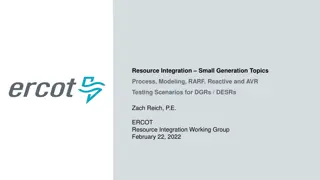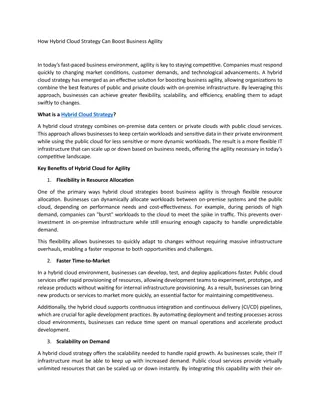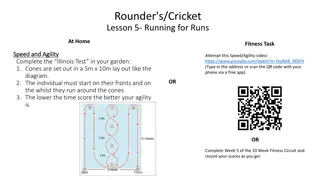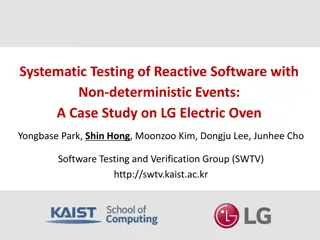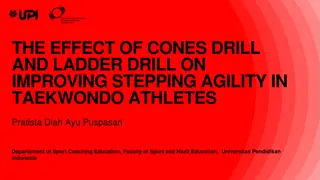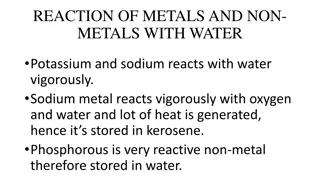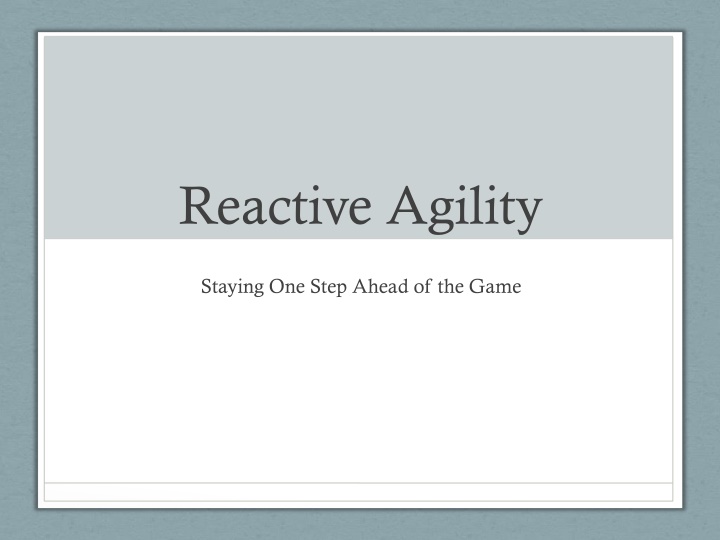
Mastering Reactive Agility for Sports Performance
Explore the concept of reactive agility in sports, focusing on rapid changes in direction and velocity in response to stimuli. Learn about the physical considerations that can enhance Change of Direction Speed (CODS), including linear speed, leg strength, power, and anthropometric characteristics. Discover how training in these areas can improve agility performance and reduce injury risks.
Download Presentation

Please find below an Image/Link to download the presentation.
The content on the website is provided AS IS for your information and personal use only. It may not be sold, licensed, or shared on other websites without obtaining consent from the author. If you encounter any issues during the download, it is possible that the publisher has removed the file from their server.
You are allowed to download the files provided on this website for personal or commercial use, subject to the condition that they are used lawfully. All files are the property of their respective owners.
The content on the website is provided AS IS for your information and personal use only. It may not be sold, licensed, or shared on other websites without obtaining consent from the author.
E N D
Presentation Transcript
Reactive Agility Staying One Step Ahead of the Game
Defining Agility In the practical setting agility has typically been recognized as the ability to change direction rapidly. This accounts for only the physical aspects of agility movements, referred to as Change of Direction Speed (CODS) In Sports, changes of direction are typically in response to a stimulus, involving significant cognitive and decision making factors.
Defining Agility The definition of agility should reflect this: An unplanned, rapid, whole-body movement with change of velocity or direction in response to a stimulus.
Physical Considerations in CODS There are several physical attributes that are thought to affect CODS: Linear Speed Leg Strength and Power Anthropometric characteristics Ground Reaction Forces (technique)
Physical Considerations in CODS Linear Speed Young (2001) and Gabbett (2008) Demonstrated that training for linear speed has no cross over to more complex CODS drills. Acceleration, Max Speed, & CODS are independent qualities.
Physical Considerations in CODS Leg Strength Research has show that one of the largest contributors to CODS is maximal leg strength. Peterson (2006) showed that strength accounted for 60% of the variance in CODS performance and 66% of performance relative to body weight. Strength training was also found to be as effective as sport specific conditioning drills in improving CODS and also has injury prevention qualities (Jullien et al., 2008).
Physical Considerations in CODS Lower Body Power While vertical jump was not found to be related to CODS performance, Plyometric training was found to improve CODS by several researchers. Young et al. (2002), Miller et al. (2006), & Thomas et al (2006) demonstrated improvements in CODS w/6 weeks of plyometric training. Likely due to the similar deceleration and push off qualities required.
Physical Considerations in CODS Anthropometric Characteristics Athletes w/higher body fat generally are slower and compete at a lower level. Taller athletes are at a biomechanical disadvantage compared w/shorter athletes making it harder to lower center of mass and apply force in the horizontal plane.
Physical Considerations in CODS Ground Reaction Forces Newton s law of Action-Reaction Vertical Medio-Lateral Anterior-Posterior Athletes must be able to create angles at the lower limb that allow maximum force generation in the desired direction. Any technical, anthropometric, or orthopedic limitation to this needs to be identified and addressed.
Elite vs Sub Elite Physical characteristics are clearly a limiting factor but are they enough? Several researchers have shown that CODS alone cannot distinguish between elite and sub elite performers. Gabbett et al. (2008) found that only when cognitive & decision making components were added to agility tests were they able to distinguish between the groups.
Elite vs Sub Elite Successful team performance relies on well developed physical qualities as well as superior anticipation and decision making skills. Cognitive factors such as visual scanning, knowledge of situations, pattern recognition, and anticipation all affect performance in elite athletes.
Cognitive Factors Visual Search Strategy Expert performers use different search strategies in different environments allowing them to efficiently extract only the pertinent information indicating direction of travel. Jackson et al. (2006) found that expert players were able to detect cues in opposition players earlier than novices.
Cognitive Factors Knowledge of Situations Williams (2000) found that expert players assign subjective probabilities to events likely to occur in a given situation. Alain & Proteau (1980) found that players evaluated the possibilities of events that could occur and used this to maximize the efficiency of their subsequent actions. Expert players made anticipatory movements whenever the possibility of success was >70%.
Cognitive Factors Expert players make better decisions based on their extensive exposure to those specific situations over many years of practice. With this exposure they develop elaborate task specific knowledge structures coupled with better encoding and retrieval processes.
Testing Reactive Agility Tests should be designed specifically for their sport due to the specific nature of an athletes expertise. Tests should use visual representations of actual athletes performing sport specific actions rather than an arbitrary stimulus.
Testing Reactive Agility Protocol: Athlete in an athletic stance on dual force plates Cones 2.5m to either side Video projection of athlete moving towards them Measured response time, movement time, ground reaction forces, lower limb angle.
Test Results Fast Thinker Fast Thinker Fast Mover Slow Mover Slow Thinker Slow Mover Fast Mover Slow Thinker
Practical Applications Slow thinkers should be placed in a proprioceptively rich environment, which should include extensive film review with and expert coach. Slow movers should spend a lot of time developing the trait that most limits their CODS abilities. This is especially important for younger athletes who need to develop their strength levels. Every limiting factor should be explored and trained specifically for the player s sport and position as well as for their individual biomechanical make up.


